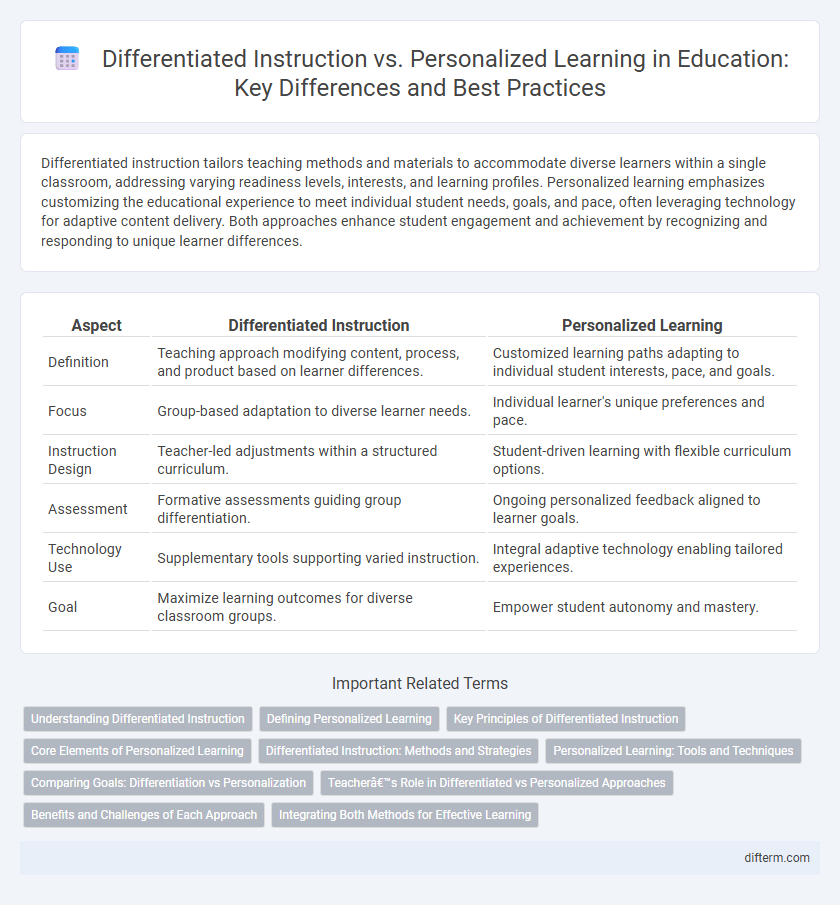Differentiated instruction tailors teaching methods and materials to accommodate diverse learners within a single classroom, addressing varying readiness levels, interests, and learning profiles. Personalized learning emphasizes customizing the educational experience to meet individual student needs, goals, and pace, often leveraging technology for adaptive content delivery. Both approaches enhance student engagement and achievement by recognizing and responding to unique learner differences.
Table of Comparison
| Aspect | Differentiated Instruction | Personalized Learning |
|---|---|---|
| Definition | Teaching approach modifying content, process, and product based on learner differences. | Customized learning paths adapting to individual student interests, pace, and goals. |
| Focus | Group-based adaptation to diverse learner needs. | Individual learner's unique preferences and pace. |
| Instruction Design | Teacher-led adjustments within a structured curriculum. | Student-driven learning with flexible curriculum options. |
| Assessment | Formative assessments guiding group differentiation. | Ongoing personalized feedback aligned to learner goals. |
| Technology Use | Supplementary tools supporting varied instruction. | Integral adaptive technology enabling tailored experiences. |
| Goal | Maximize learning outcomes for diverse classroom groups. | Empower student autonomy and mastery. |
Understanding Differentiated Instruction
Differentiated instruction involves tailoring teaching methods, materials, and assessments to address diverse student readiness levels, learning styles, and interests within a classroom. This approach emphasizes group-based strategies, creating flexible learning environments that accommodate varied learner needs simultaneously. By adjusting content, process, and product, educators ensure all students access curriculum effectively while promoting engagement and growth.
Defining Personalized Learning
Personalized learning tailors educational experiences to individual students' strengths, interests, and needs, promoting autonomy and engagement through adaptive content and flexible pacing. Unlike differentiated instruction, which modifies teaching strategies within a uniform curriculum for groups, personalized learning customizes the curriculum itself to optimize each learner's growth. Data-driven technologies and learner analytics are integral to implementing effective personalized learning environments.
Key Principles of Differentiated Instruction
Differentiated instruction centers on tailoring teaching methods, content, and assessments to accommodate students' varying readiness levels, interests, and learning profiles within a single classroom. Key principles include flexible grouping, ongoing assessment, and adjusting instructional strategies to meet diverse learners' needs. This approach emphasizes providing multiple pathways for students to access content, engage in learning, and demonstrate mastery.
Core Elements of Personalized Learning
Personalized learning centers on tailoring educational experiences to individual student needs, interests, and learning styles, employing adaptive technology, flexible pacing, and student voice in goal setting. Unlike differentiated instruction, which modifies content, process, or product based on predefined student groups, personalized learning emphasizes learner agency and continuous feedback loops. Core elements include customized learning pathways, competency-based progression, and active engagement through meaningful choice and collaboration.
Differentiated Instruction: Methods and Strategies
Differentiated instruction employs varied teaching methods such as flexible grouping, tiered assignments, and varied questioning techniques to address the diverse learning styles and readiness levels within a classroom. Strategies like using learning contracts, adjustable content complexity, and ongoing formative assessments help tailor instruction to student needs without altering curriculum goals. This approach enhances engagement and comprehension by providing multiple pathways for students to access content and demonstrate understanding.
Personalized Learning: Tools and Techniques
Personalized learning utilizes adaptive technology platforms such as learning management systems (LMS) and AI-driven applications to tailor educational content to individual student needs, pacing, and preferences. Techniques include competency-based progression, which allows learners to advance upon mastery, and the integration of data analytics to monitor progress and adjust instruction dynamically. Tools like interactive simulations, personalized feedback mechanisms, and customizable learning paths enhance engagement and ensure targeted skill development.
Comparing Goals: Differentiation vs Personalization
Differentiated instruction aims to address diverse student needs by tailoring teaching methods, content, and assessment within a shared curriculum to ensure all learners achieve common educational goals. Personalized learning focuses on individual students' interests, strengths, and learning pace, creating a customized educational experience that promotes autonomy and intrinsic motivation. While differentiation adapts traditional classroom strategies, personalization transforms learning into a student-driven process aligned with personal aspirations.
Teacher’s Role in Differentiated vs Personalized Approaches
Teachers in differentiated instruction design varied activities to address diverse learning styles within a single classroom, adapting content, process, and product based on student readiness and interests. In personalized learning, educators act more as facilitators or coaches, creating individualized learning paths that empower students to set goals and engage with material at their own pace. The teacher's role shifts from delivering uniform lessons to curating dynamic, student-centered experiences that foster autonomy and self-directed growth.
Benefits and Challenges of Each Approach
Differentiated instruction enhances student engagement and academic growth by tailoring teaching methods to diverse learning styles, but it can challenge teachers with increased planning time and classroom management complexity. Personalized learning offers customized educational experiences using technology and data analytics, promoting autonomy and mastery; however, it may require significant resources and digital literacy for effective implementation. Balancing these approaches can optimize student outcomes by addressing individual needs while maintaining collaborative classroom dynamics.
Integrating Both Methods for Effective Learning
Integrating differentiated instruction and personalized learning creates a dynamic educational environment that addresses diverse student needs by tailoring content, process, and product based on readiness, interests, and learning profiles. Utilizing data-driven assessments and adaptive technologies enhances this integration, enabling educators to design flexible learning pathways and foster student autonomy. Combining these methods improves engagement, achievement, and skill development by promoting inclusive, responsive instruction that evolves with each learner's progress.
Differentiated instruction vs Personalized learning Infographic

 difterm.com
difterm.com